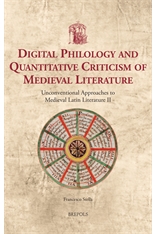Francesco Stella, Digital Philology and Quantitative Criticism of Medieval Literature: Unconventional Approaches to Medieval Latin Literature II (Turnhout, 2020: USML 49), xii+279 pp. ISBN 978-2-503-58801-8.
Building on The Carolingian Revolution: Unconventional Approaches to Medieval Latin Literature I, this is the second of two volumes proposing ways of reading medieval Latin texts which, up to now, have had little or no attention within literary studies. This volume is founded on the belief that ‘the unprecedented empirical power of digital tools and archives offers a unique chance to rethink the categories of literary study’ (F. Moretti).
The book’s first section presents cases studies applying ‘quantitative’ criticism based on the linguistic and stylistic use of frequency wordlists which, thanks to digital tools and to a larger literature, are becoming more easily accessible and more powerful. The chapters of this section lead the reader from an application of stylometry within a traditional critical exercise, via the structured use of frequency indexing as a warning light for cultural or stylistic phenomena undetectable to the naked eye, to more technical corpus analysis experiments based on linguistic evolution or authorship attribution. The second section explores the encoding problems the author has faced when working on the realisation of digital editing projects such as the Corpus Rhythmorum Musicum, the Archivio della Latinità Italiana del Medioevo (ALIM), Lexicon, and the Eurasian Latin Archive (ELA), and proposes reflections on the typology of digital philological editions.
Contents:
The Mechanic Reader: Instead of an Introduction
Quantitative Criticism
Chapter 1. Venantius Fortunatus in Medieval Latin Poetry
Chapter 2. The Representations of the Book in Carolingian and Ottonian Poetic Texts: The Birth of Paratextual Poetry
Chapter 3. Europe’s Name is Europa: ‘Europe’ and ‘European’ in Early Medieval Latin Texts
Chapter 4. The Landscape as a Memory Construction in the Latin Petrarch
Chapter 5. Generic Constants and Chronological Variations in Statistical Linguistics on Latin Epistolography
Chapter 6. Statistical Indicators of Proximity to the Early Romance Languages: Experimental Applications to Early Medieval Rhythmic Poetry
Chapter 7. Computer Analysis of the Lexicon and Identification of the Authors in the Epistolae duorum amantium (Twelfth Century)
Digital Philology
Chapter 8. Encoding Issues in Philological Digital Editions
Chapter 9. Digital Philology, Medieval Texts, and the Corpus Rhythmorum Musicum, a Digital Edition of Music and Poems
Bibliography
Indices


